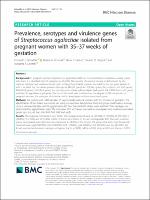| dc.creator | Bobadilla, Fernando Javier | |
| dc.creator | Novosak, Marina Gisel | |
| dc.creator | Cortese, Iliana Julieta | |
| dc.creator | Delgado, Osvaldo Daniel | |
| dc.creator | Laczeski, Margarita Ester | |
| dc.date.accessioned | 2023-08-26T12:25:57Z | |
| dc.date.available | 2023-08-26T12:25:57Z | |
| dc.date.issued | 2021-12-30 | |
| dc.identifier.citation | Bobadilla, F.J., Novosak, M.G., Cortese, I.J., Delgado, O.D., Laczeski, M.E. (2022). Prevalence, serotypes and virulence genes of streptococcus agalactiae isolated from pregnant women with 35–37 weeks of gestation. BMC Infectious Diseases. Reino Unido : BioMed Central, 21(1), 11 p. | es_AR |
| dc.identifier.issn | 1471-2334 | |
| dc.identifier.other | 27220 | |
| dc.identifier.other | CCPI-CNyE-A-185 | |
| dc.identifier.uri | https://hdl.handle.net/20.500.12219/5099 | |
| dc.description | Fil: Bobadilla, Fernando Javier. Consejo Nacional de Investigaciones Científicas y Técnicas; Argentina. | es_AR |
| dc.description | Fil: Bobadilla, Fernando Javier. Universidad Nacional de Misiones. Facultad de Ciencias Exactas, Químicas y Naturales. Departamento de Microbiología; Argentina. | es_AR |
| dc.description | Fil: Novosak, Marina Gisel. Consejo Nacional de Investigaciones Científicas y Técnicas; Argentina. | es_AR |
| dc.description | Fil: Novosak, Marina Gisel. Universidad Nacional de Misiones. Facultad de Ciencias Exactas, Químicas y Naturales. Departamento de Microbiología; Argentina. | es_AR |
| dc.description | Fil: Novosak, Marina Gisel. Consejo Nacional de Investigaciones Científicas y Técnicas. Instituto de Biotecnología de Misiones; Argentina. | es_AR |
| dc.description | Fil: Novosak, Marina Gisel. Universidad Nacional de Misiones. Facultad de Ciencias Exactas, Químicas y Naturales. Instituto de Biotecnología de Misiones; Argentina. | es_AR |
| dc.description | Fil: Cortese, Iliana Julieta. Consejo Nacional de Investigaciones Científicas y Técnicas. Instituto de Biotecnología de Misiones; Argentina. | es_AR |
| dc.description | Fil: Cortese, Iliana Julieta. Universidad Nacional de Misiones. Facultad de Ciencias Exactas, Químicas y Naturales. Instituto de Biotecnología de Misiones; Argentina. | es_AR |
| dc.description | Fil: Delgado, Osvaldo Daniel. Consejo Nacional de Investigaciones Científicas y Técnicas. Planta Piloto de Procesos Industriales Microbiológicos; Argentina. | es_AR |
| dc.description | Fil: Delgado, Osvaldo Daniel. Universidad Nacional de Catamarca. Planta Piloto de Procesos Industriales Microbiológicos; Argentina. | es_AR |
| dc.description | Fil: Laczeski, Margarita Ester. Consejo Nacional de Investigaciones Científicas y Técnicas; Argentina. | es_AR |
| dc.description | Fil: Laczeski, Margarita Ester. Universidad Nacional de Misiones. Facultad de Ciencias Exactas, Químicas y Naturales. Departamento de Microbiología; Argentina. | es_AR |
| dc.description | Fil: Laczeski, Margarita Ester. Consejo Nacional de Investigaciones Científicas y Técnicas. Instituto de Biotecnología de Misiones; Argentina. | es_AR |
| dc.description | Fil: Laczeski, Margarita Ester. Universidad Nacional de Misiones. Facultad de Ciencias Exactas, Químicas y Naturales. Instituto de Biotecnología de Misiones; Argentina. | es_AR |
| dc.description.abstract | Background: In pregnant women Streptococcus agalactiae (GBS) can be transmitted to newborn causing severe infections. It is classified into 10 serotypes (Ia, Ib, II-IX). The severity of neonatal disease is determined by the capsular serotype and virulence factors such as the polysaccharide capsule, encoded by the cps gene, protein C,
which includes the Cα surface proteins (bca gene), Rib (rib gene) and Cβ (bac gene); the proteins Lmb (lmb gene), FbsB (fbsB gene), FbsA (fbsA gene), the cyl operon encoding a β-hemolysin (hylB gene), the CAMP factor (cfb gene) and the C5a peptidase (scpB gene). The aim of this work was to determine the degree of GBS colonization in pregnant women, the serotypes distribution and to investigate virulence-associated genes.
Methods: We worked with 3480 samples of vagino-rectal swabs of women with 35–37 weeks of gestation. The identification of the strains was carried out using conventional biochemical tests and group confirmatory serology using a commercial latex particle agglutination kit. Two hundred GBS strains were selected. Their serotype was
determined by agglutination tests. The monoplex PCR technique was used to investigate nine virulence-associated genes (cps, bca, rib, bac, lmb, fbsB, fbsA, hylB and scpB).
Results: The maternal colonization was 9.09%. The serotypes found were: Ia (33.50%), III (19.00%), Ib (15.50%), II (14.00%), V (7.00%) and IX (5.50%). 5.50% of strains were found to be non-serotypeable (NT). The nine virulence
genes investigated were detected simultaneously in 36.50% of the strains. The genes that were most frequently detected were scpB (100.00%), fbsA (100.00%), fbsB (100.00%), cylB (95.00%), lmb (94.00%) and bca (87.50%). We found associations between serotype and genes bac (p = 0.003), cylB (p = 0.02), rib (p = 0.01) and lmb (p < 0.001).
Conclusions: The frequency of vaginal-rectal colonization, serotypes distribution and associated virulence genes,
varies widely among geographical areas. Therefore, epidemiological surveillance is necessary to provide data to
guide decision-making and planning of prevention and control strategies. | es_AR |
| dc.format | application/pdf | |
| dc.format.extent | 1.3 MB | |
| dc.language.iso | eng | es_AR |
| dc.publisher | BioMed Central | es_AR |
| dc.relation | info:eu-repo/semantics/altIdentifier/hdl/http://hdl.handle.net/11336/133884 | |
| dc.relation | info:eu-repo/semantics/altIdentifier/urn/https://bmcinfectdis.biomedcentral.com/articles/10.1186/s12879-020-05603-5 | |
| dc.relation | info:eu-repo/semantics/altIdentifier/urn/https://link.springer.com/article/10.1186/s12879-020-05603-5 | |
| dc.rights | info:eu-repo/semantics/openAccess | |
| dc.subject | GBS | es_AR |
| dc.subject | Colonization | es_AR |
| dc.subject | Serotypes | es_AR |
| dc.subject | Virulence genes | es_AR |
| dc.title | Prevalence, serotypes and virulence genes of streptococcus agalactiae isolated from pregnant women with 35–37 weeks of gestation | es_AR |
| dc.type | info:eu-repo/semantics/article | es_AR |
| dc.type | info:ar-repo/semantics/artículo | |
| dc.type | info:eu-repo/semantics/publishedVersion | |



